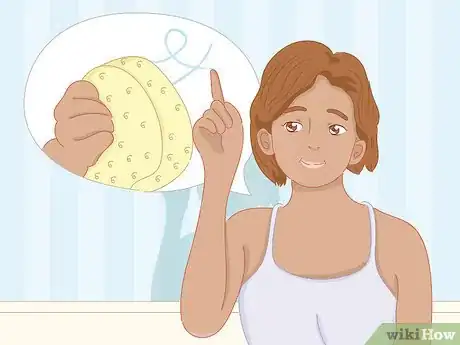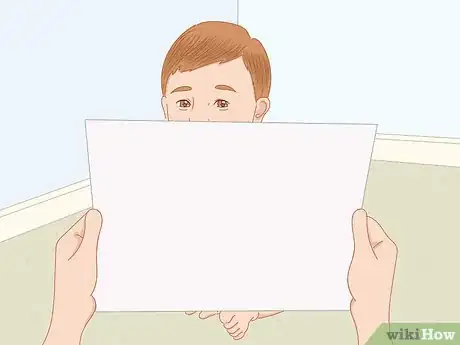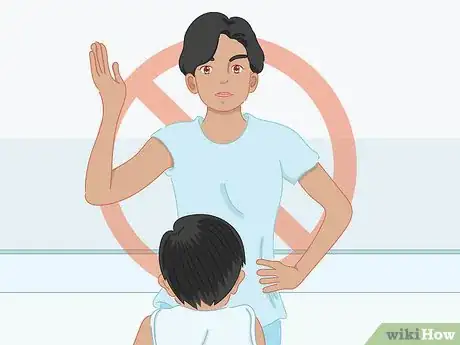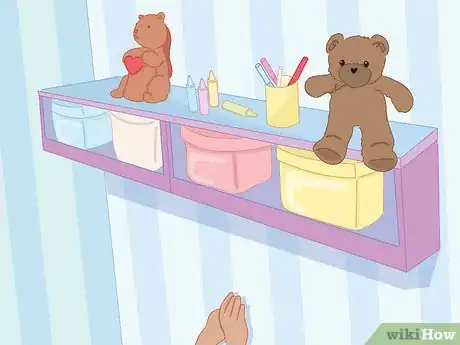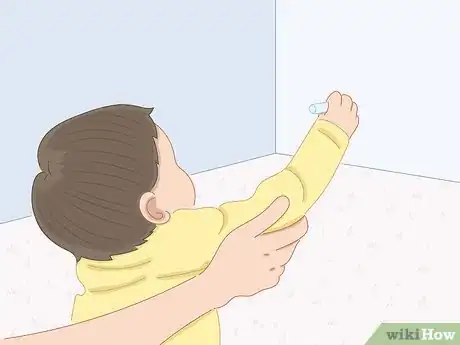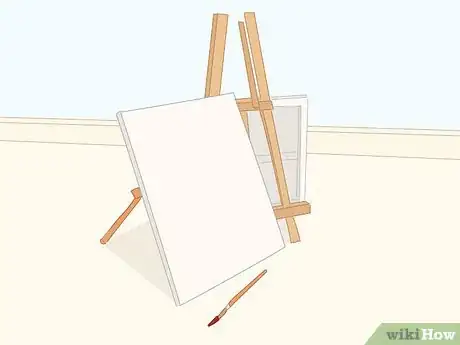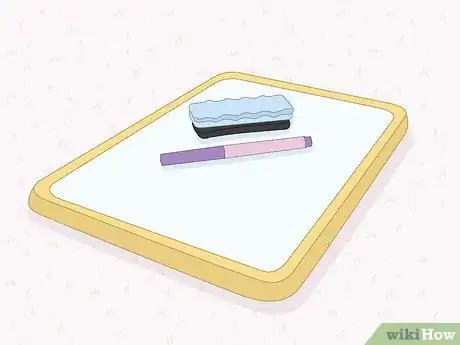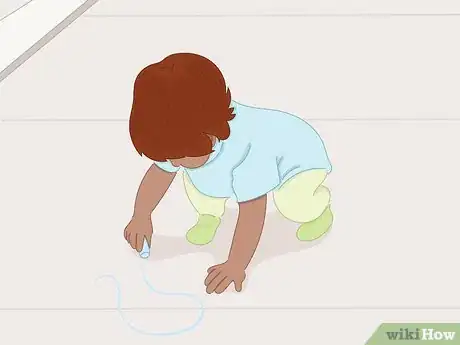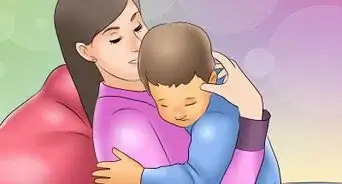This article was co-authored by Catherine Palomino, MS and by wikiHow staff writer, Jessica Gibson. Catherine Palomino is a former Childcare Center Director in New York. She received her MS in Elementary Education from CUNY Brooklyn College in 2010.
This article has been viewed 76,487 times.
Toddlers are naturally curious and are still learning boundaries. If you've caught your toddler doodling on the walls, remember not to react in anger. Instead, use simple language to stop them and redirect them to an acceptable drawing space. Remind your toddler that you enjoy their scribbles so long as they're not on the walls.
Steps
Responding to Wall Scribbles
-
1Use clear language to stop the toddler from drawing on the wall. As soon as you see the child writing or drawing on the wall, calmly tell them to stop. Instead of lecturing the toddler about why we don't write on walls, use short sentences to get them to stop.[1]
- For example, say, "Put the crayon down, please! Walls are not for drawing."
- For younger toddlers, fewer words are better: "Crayons go on paper!"
-
2Ask the toddler to help you clean the wall. Let the toddler know that they're not in trouble for scribbling, but that the wall is not the place to do it and now the wall needs to be cleaned off. Don't use cleaning as a punishment or they may associating drawing with punishment.[2]
- For example, say, "This wall has crayon on it now. Please help me clean it off. Then, we can draw on paper at the table."
- Thank your toddler when they help you clean up their scribbles. This will help reinforce the idea that you prefer clean walls, and it will make their actions seem valued.
Advertisement -
3Redirect the toddler to an appropriate drawing space. It's important to let your toddler know that drawing and scribbling are great as long as they're in the right place. Once you've told the toddler to stop scribbling on the walls, show them where they're allowed to write.[3]
- You might say, "Let's go over to the easel and I can watch you draw a picture."
-
4Avoid reacting in anger to your toddler's scribbles. Never hit or yell at a toddler when you see that they've written on the walls. Reacting in anger can damage your relationship and make it more likely that the toddler will keep drawing on the walls to get a reaction.[4]
- It's fine to let your toddler know that you're sad that they wrote on the walls. Your sadness may signal to the child that they need to be more thoughtful.
Encouraging Appropriate Drawing
-
1Keep messy art supplies out of reach when they're not in use. While you're training your toddler to not write on the walls, ensure that they don't have access to the art supplies without supervision. Put them on a high shelf, in a cabinet with a lock, or in the closet of a closed-off room.[5]
- Purchase washable art supplies such as non-toxic washable crayons, markers, and paints. Washable supplies will be easier to wash off of the walls if your toddler makes a mistake.
- Avoid letting your child write or draw with permanent pens and markers.
-
2Stay with your toddler while they're scribbling. It may take some time for your toddler to learn that the walls aren't for drawing. In the meantime, always supervise them while they're drawing, painting, or coloring. Gently correct them if they move away from their drawing space.[6]
- For example, if the toddler gets up and goes over to the wall while they have a marker in their hand, say, "You need to come over to your paper. Markers aren't for walls." Then, offer them thanks or praise when they start using their paper.
-
3Set up an easel or large pad of paper on a board. Some toddlers prefer to write on the walls because it's easier for them to stand and scribble instead of sitting. To make it easier for them to draw, put up an easel or prop a sturdy board up against the wall. Attach a large pad of paper to the easel or board.[7]
- If you're using the board, ensure that it won't fall or slide out from under your toddler.
-
4Offer whiteboards with erasable markers. If your toddler loves to take markers to the walls, give them a large whiteboard to scribble on. Set out non-toxic dry erase markers and show them how they can erase their drawings once they're done with them.[8]
- Remember to keep the markers out of reach when your child has finished drawing on the whiteboard.
-
5Show your child other acceptable places to write. Your child might write on the walls because they seem like a fun or unusual place to create. Take your curious doodler outside and let them use chalk or sidewalk paint on the sidewalk or patio. If it's winter time, give them colored water to paint the snow with. During playtime, give them papers in a variety of colors and textures to experiment with.[9]
- For a fun indoor space, buy bath crayons or paints and let your toddler write on the tub during bath time.
-
6Praise your toddler when they use a designated drawing space. Kids respond well to positive feedback, so it's important to reward good behavior every time you see it. Your toddler will be pleased that you appreciate and are interested in their drawing.[10]
- For example, watch your toddler color for a minute or two on an easel or writing pad. Then say, "I love watching you write on your nice paper!"
Community Q&A
-
QuestionHow do I paint over crayon markings?
 Community AnswerFirst, sand the area with fine sandpaper and wipe clean. This will roughen up the surface so the paint will adhere to the wall.
Community AnswerFirst, sand the area with fine sandpaper and wipe clean. This will roughen up the surface so the paint will adhere to the wall.
References
- ↑ http://bartelart.com/arted/wallscribblers.html
- ↑ http://bartelart.com/arted/wallscribblers.html
- ↑ http://bartelart.com/arted/wallscribblers.html
- ↑ http://bartelart.com/arted/wallscribblers.html
- ↑ https://www.parents.com/toddlers-preschoolers/safety/toddlerproofing/home-safe-home-childproof-your-home-room-by-room/
- ↑ https://www.thewatsoninstitute.org/watson-life-resources/situation/replacement-behavior-writing-wall/
- ↑ https://www.parenting.com/article/drawing-on-the-walls
- ↑ http://bartelart.com/arted/wallscribblers.html
- ↑ https://whatmomslove.com/kids/sidewalk-chalk-ideas/
About This Article
If you’re trying to get a toddler to stop drawing on the walls, start by calmly and clearly telling them to stop, saying something like “Put the crayon down, please. Walls are not for drawing.” Then, ask them to help you clean the wall, and thank them when they do. Next, tell your toddler that drawing is great when it’s done in the right place, and show them where they can do it, like on a piece of construction paper or at an easel. Finally, praise your toddler when they use appropriate drawing spaces, since kids respond well to positive feedback. For more advice from our Childcare reviewer, including how to store your art supplies so your toddler can't get into them without supervision, read on!

